Research Plan: Mobile Computing Opportunities and Challenges Analysis
VerifiedAdded on 2020/03/16
|14
|3710
|75
Report
AI Summary
This research plan delves into the realm of mobile computing, specifically investigating the opportunities and challenges associated with cloud computing within the IT industry. The report begins with an introduction to cloud computing, defining its role in data storage and accessibility. The project objectives are to analyze these opportunities and challenges, focusing on potential issues companies may face when implementing cloud services. A literature review examines the impact of cloud computing on the IT industry, including its benefits and drawbacks, such as cost considerations and data security. Research questions are formulated to address gaps in the literature, including opportunities and challenges. The research design incorporates both qualitative and quantitative methodologies, detailing data collection methods like questionnaires and interviews, along with sampling techniques. The research also acknowledges limitations like sample size and potential deviations in outcomes. The report concludes with a discussion of the research's implications.
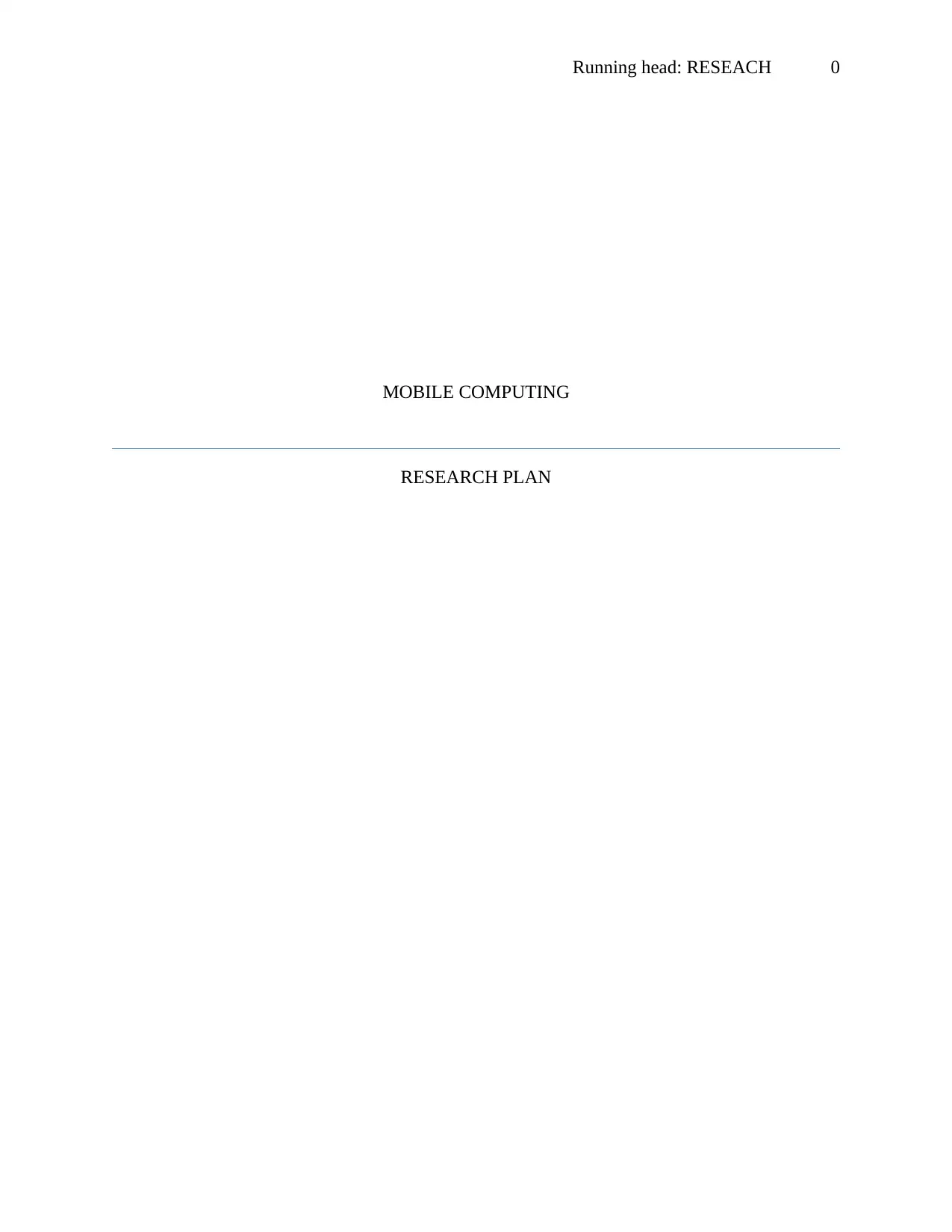
Running head: RESEACH 0
MOBILE COMPUTING
RESEARCH PLAN
MOBILE COMPUTING
RESEARCH PLAN
Paraphrase This Document
Need a fresh take? Get an instant paraphrase of this document with our AI Paraphraser
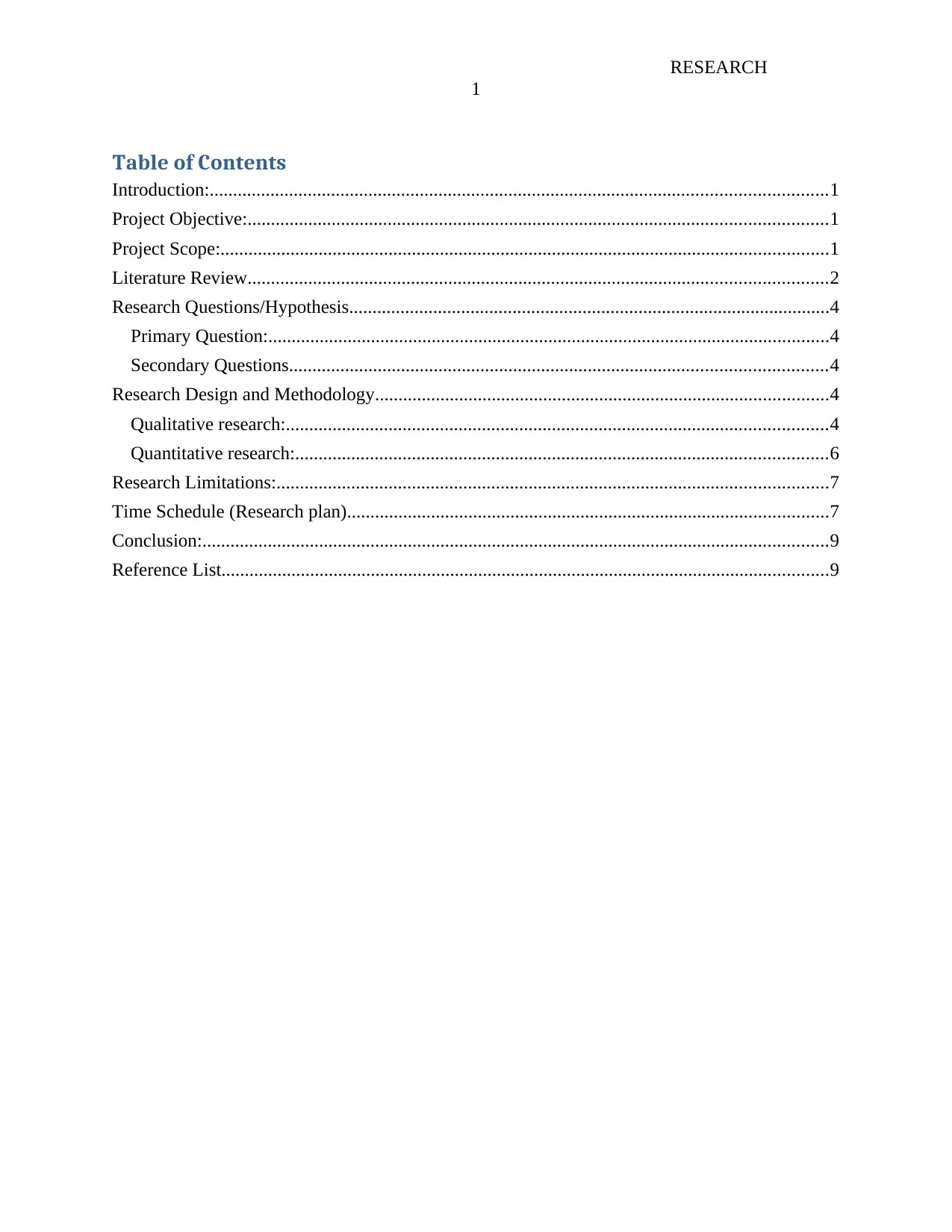
RESEARCH
1
Table of Contents
Introduction:....................................................................................................................................1
Project Objective:............................................................................................................................1
Project Scope:..................................................................................................................................1
Literature Review............................................................................................................................2
Research Questions/Hypothesis.......................................................................................................4
Primary Question:........................................................................................................................4
Secondary Questions...................................................................................................................4
Research Design and Methodology.................................................................................................4
Qualitative research:....................................................................................................................4
Quantitative research:..................................................................................................................6
Research Limitations:......................................................................................................................7
Time Schedule (Research plan).......................................................................................................7
Conclusion:......................................................................................................................................9
Reference List..................................................................................................................................9
1
Table of Contents
Introduction:....................................................................................................................................1
Project Objective:............................................................................................................................1
Project Scope:..................................................................................................................................1
Literature Review............................................................................................................................2
Research Questions/Hypothesis.......................................................................................................4
Primary Question:........................................................................................................................4
Secondary Questions...................................................................................................................4
Research Design and Methodology.................................................................................................4
Qualitative research:....................................................................................................................4
Quantitative research:..................................................................................................................6
Research Limitations:......................................................................................................................7
Time Schedule (Research plan).......................................................................................................7
Conclusion:......................................................................................................................................9
Reference List..................................................................................................................................9
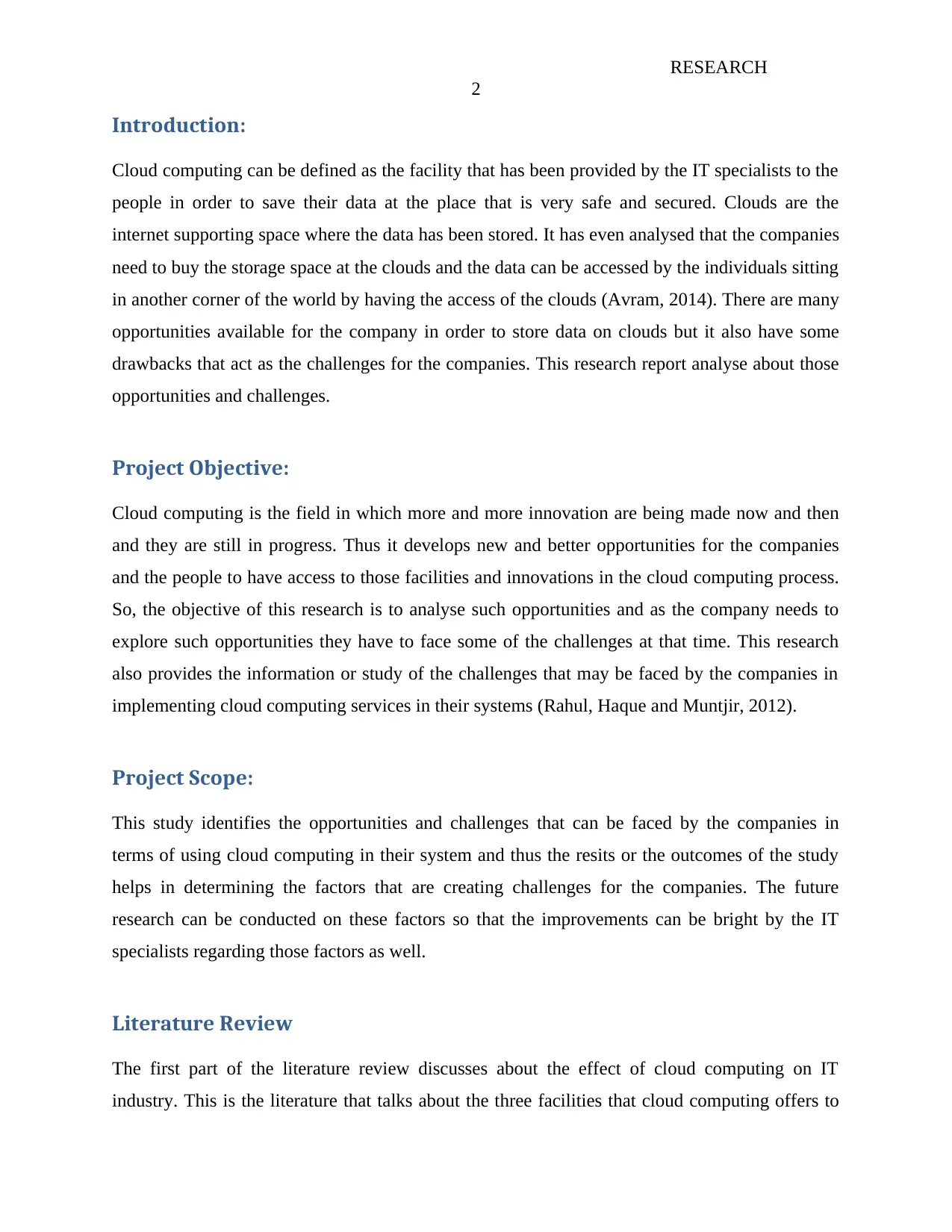
RESEARCH
2
Introduction:
Cloud computing can be defined as the facility that has been provided by the IT specialists to the
people in order to save their data at the place that is very safe and secured. Clouds are the
internet supporting space where the data has been stored. It has even analysed that the companies
need to buy the storage space at the clouds and the data can be accessed by the individuals sitting
in another corner of the world by having the access of the clouds (Avram, 2014). There are many
opportunities available for the company in order to store data on clouds but it also have some
drawbacks that act as the challenges for the companies. This research report analyse about those
opportunities and challenges.
Project Objective:
Cloud computing is the field in which more and more innovation are being made now and then
and they are still in progress. Thus it develops new and better opportunities for the companies
and the people to have access to those facilities and innovations in the cloud computing process.
So, the objective of this research is to analyse such opportunities and as the company needs to
explore such opportunities they have to face some of the challenges at that time. This research
also provides the information or study of the challenges that may be faced by the companies in
implementing cloud computing services in their systems (Rahul, Haque and Muntjir, 2012).
Project Scope:
This study identifies the opportunities and challenges that can be faced by the companies in
terms of using cloud computing in their system and thus the resits or the outcomes of the study
helps in determining the factors that are creating challenges for the companies. The future
research can be conducted on these factors so that the improvements can be bright by the IT
specialists regarding those factors as well.
Literature Review
The first part of the literature review discusses about the effect of cloud computing on IT
industry. This is the literature that talks about the three facilities that cloud computing offers to
2
Introduction:
Cloud computing can be defined as the facility that has been provided by the IT specialists to the
people in order to save their data at the place that is very safe and secured. Clouds are the
internet supporting space where the data has been stored. It has even analysed that the companies
need to buy the storage space at the clouds and the data can be accessed by the individuals sitting
in another corner of the world by having the access of the clouds (Avram, 2014). There are many
opportunities available for the company in order to store data on clouds but it also have some
drawbacks that act as the challenges for the companies. This research report analyse about those
opportunities and challenges.
Project Objective:
Cloud computing is the field in which more and more innovation are being made now and then
and they are still in progress. Thus it develops new and better opportunities for the companies
and the people to have access to those facilities and innovations in the cloud computing process.
So, the objective of this research is to analyse such opportunities and as the company needs to
explore such opportunities they have to face some of the challenges at that time. This research
also provides the information or study of the challenges that may be faced by the companies in
implementing cloud computing services in their systems (Rahul, Haque and Muntjir, 2012).
Project Scope:
This study identifies the opportunities and challenges that can be faced by the companies in
terms of using cloud computing in their system and thus the resits or the outcomes of the study
helps in determining the factors that are creating challenges for the companies. The future
research can be conducted on these factors so that the improvements can be bright by the IT
specialists regarding those factors as well.
Literature Review
The first part of the literature review discusses about the effect of cloud computing on IT
industry. This is the literature that talks about the three facilities that cloud computing offers to
⊘ This is a preview!⊘
Do you want full access?
Subscribe today to unlock all pages.

Trusted by 1+ million students worldwide
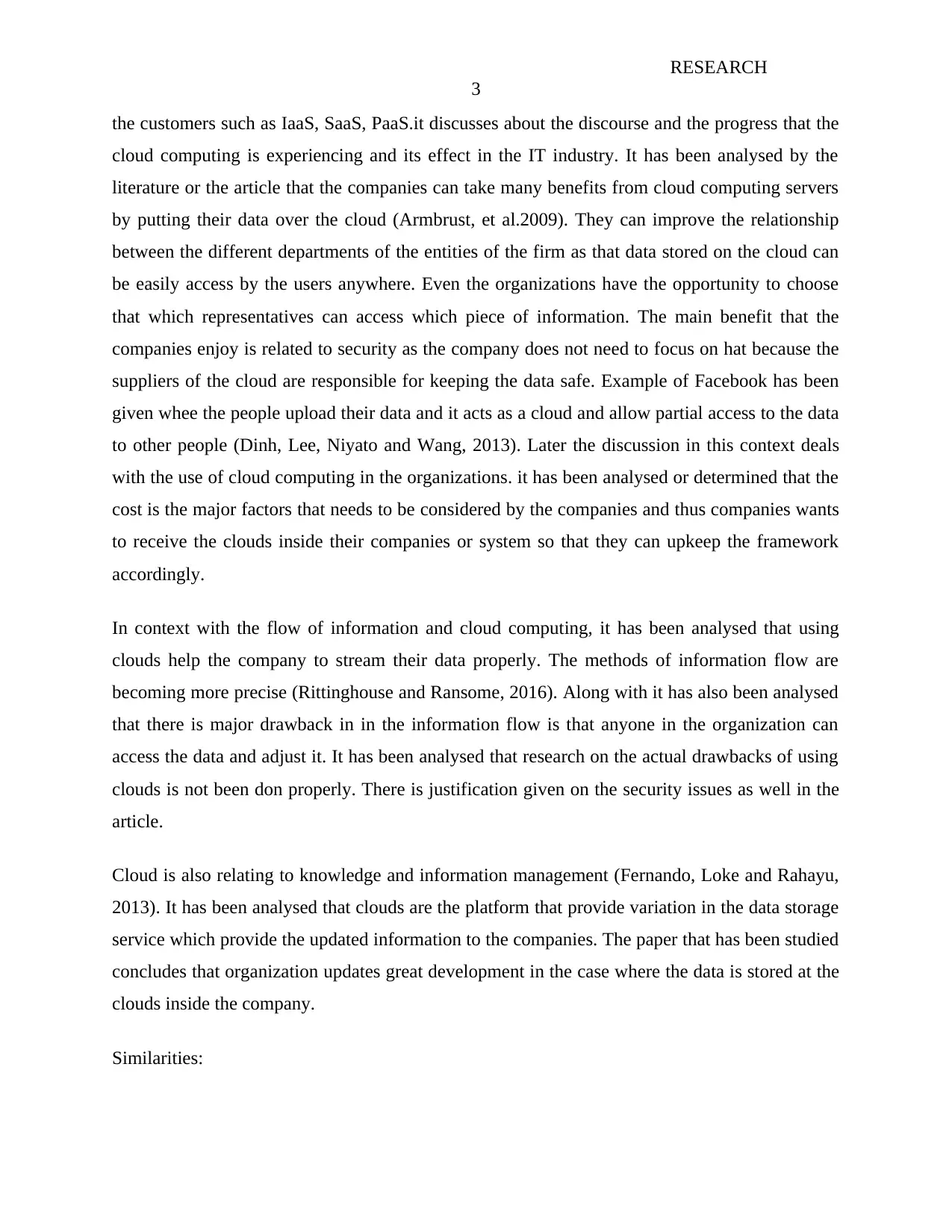
RESEARCH
3
the customers such as IaaS, SaaS, PaaS.it discusses about the discourse and the progress that the
cloud computing is experiencing and its effect in the IT industry. It has been analysed by the
literature or the article that the companies can take many benefits from cloud computing servers
by putting their data over the cloud (Armbrust, et al.2009). They can improve the relationship
between the different departments of the entities of the firm as that data stored on the cloud can
be easily access by the users anywhere. Even the organizations have the opportunity to choose
that which representatives can access which piece of information. The main benefit that the
companies enjoy is related to security as the company does not need to focus on hat because the
suppliers of the cloud are responsible for keeping the data safe. Example of Facebook has been
given whee the people upload their data and it acts as a cloud and allow partial access to the data
to other people (Dinh, Lee, Niyato and Wang, 2013). Later the discussion in this context deals
with the use of cloud computing in the organizations. it has been analysed or determined that the
cost is the major factors that needs to be considered by the companies and thus companies wants
to receive the clouds inside their companies or system so that they can upkeep the framework
accordingly.
In context with the flow of information and cloud computing, it has been analysed that using
clouds help the company to stream their data properly. The methods of information flow are
becoming more precise (Rittinghouse and Ransome, 2016). Along with it has also been analysed
that there is major drawback in in the information flow is that anyone in the organization can
access the data and adjust it. It has been analysed that research on the actual drawbacks of using
clouds is not been don properly. There is justification given on the security issues as well in the
article.
Cloud is also relating to knowledge and information management (Fernando, Loke and Rahayu,
2013). It has been analysed that clouds are the platform that provide variation in the data storage
service which provide the updated information to the companies. The paper that has been studied
concludes that organization updates great development in the case where the data is stored at the
clouds inside the company.
Similarities:
3
the customers such as IaaS, SaaS, PaaS.it discusses about the discourse and the progress that the
cloud computing is experiencing and its effect in the IT industry. It has been analysed by the
literature or the article that the companies can take many benefits from cloud computing servers
by putting their data over the cloud (Armbrust, et al.2009). They can improve the relationship
between the different departments of the entities of the firm as that data stored on the cloud can
be easily access by the users anywhere. Even the organizations have the opportunity to choose
that which representatives can access which piece of information. The main benefit that the
companies enjoy is related to security as the company does not need to focus on hat because the
suppliers of the cloud are responsible for keeping the data safe. Example of Facebook has been
given whee the people upload their data and it acts as a cloud and allow partial access to the data
to other people (Dinh, Lee, Niyato and Wang, 2013). Later the discussion in this context deals
with the use of cloud computing in the organizations. it has been analysed or determined that the
cost is the major factors that needs to be considered by the companies and thus companies wants
to receive the clouds inside their companies or system so that they can upkeep the framework
accordingly.
In context with the flow of information and cloud computing, it has been analysed that using
clouds help the company to stream their data properly. The methods of information flow are
becoming more precise (Rittinghouse and Ransome, 2016). Along with it has also been analysed
that there is major drawback in in the information flow is that anyone in the organization can
access the data and adjust it. It has been analysed that research on the actual drawbacks of using
clouds is not been don properly. There is justification given on the security issues as well in the
article.
Cloud is also relating to knowledge and information management (Fernando, Loke and Rahayu,
2013). It has been analysed that clouds are the platform that provide variation in the data storage
service which provide the updated information to the companies. The paper that has been studied
concludes that organization updates great development in the case where the data is stored at the
clouds inside the company.
Similarities:
Paraphrase This Document
Need a fresh take? Get an instant paraphrase of this document with our AI Paraphraser
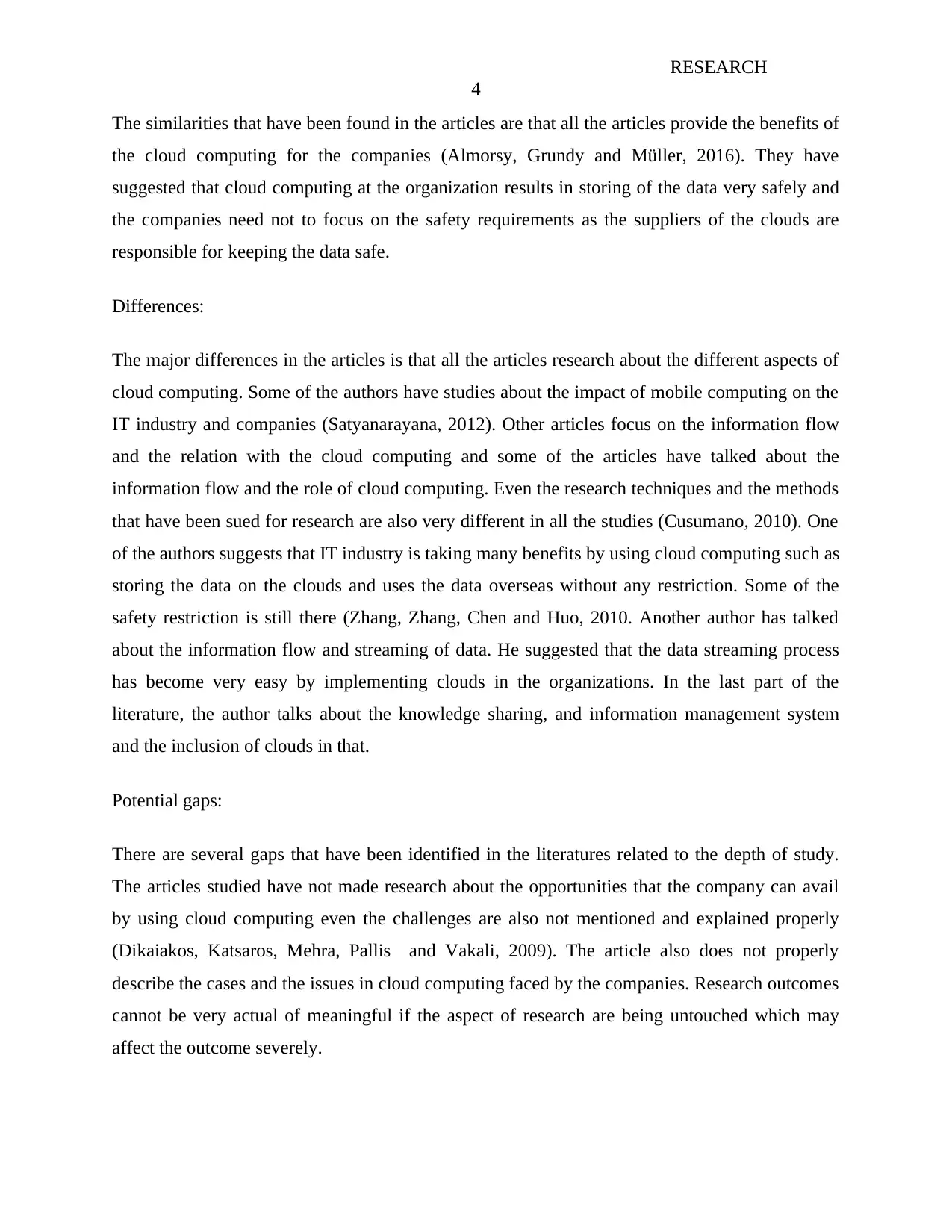
RESEARCH
4
The similarities that have been found in the articles are that all the articles provide the benefits of
the cloud computing for the companies (Almorsy, Grundy and Müller, 2016). They have
suggested that cloud computing at the organization results in storing of the data very safely and
the companies need not to focus on the safety requirements as the suppliers of the clouds are
responsible for keeping the data safe.
Differences:
The major differences in the articles is that all the articles research about the different aspects of
cloud computing. Some of the authors have studies about the impact of mobile computing on the
IT industry and companies (Satyanarayana, 2012). Other articles focus on the information flow
and the relation with the cloud computing and some of the articles have talked about the
information flow and the role of cloud computing. Even the research techniques and the methods
that have been sued for research are also very different in all the studies (Cusumano, 2010). One
of the authors suggests that IT industry is taking many benefits by using cloud computing such as
storing the data on the clouds and uses the data overseas without any restriction. Some of the
safety restriction is still there (Zhang, Zhang, Chen and Huo, 2010. Another author has talked
about the information flow and streaming of data. He suggested that the data streaming process
has become very easy by implementing clouds in the organizations. In the last part of the
literature, the author talks about the knowledge sharing, and information management system
and the inclusion of clouds in that.
Potential gaps:
There are several gaps that have been identified in the literatures related to the depth of study.
The articles studied have not made research about the opportunities that the company can avail
by using cloud computing even the challenges are also not mentioned and explained properly
(Dikaiakos, Katsaros, Mehra, Pallis and Vakali, 2009). The article also does not properly
describe the cases and the issues in cloud computing faced by the companies. Research outcomes
cannot be very actual of meaningful if the aspect of research are being untouched which may
affect the outcome severely.
4
The similarities that have been found in the articles are that all the articles provide the benefits of
the cloud computing for the companies (Almorsy, Grundy and Müller, 2016). They have
suggested that cloud computing at the organization results in storing of the data very safely and
the companies need not to focus on the safety requirements as the suppliers of the clouds are
responsible for keeping the data safe.
Differences:
The major differences in the articles is that all the articles research about the different aspects of
cloud computing. Some of the authors have studies about the impact of mobile computing on the
IT industry and companies (Satyanarayana, 2012). Other articles focus on the information flow
and the relation with the cloud computing and some of the articles have talked about the
information flow and the role of cloud computing. Even the research techniques and the methods
that have been sued for research are also very different in all the studies (Cusumano, 2010). One
of the authors suggests that IT industry is taking many benefits by using cloud computing such as
storing the data on the clouds and uses the data overseas without any restriction. Some of the
safety restriction is still there (Zhang, Zhang, Chen and Huo, 2010. Another author has talked
about the information flow and streaming of data. He suggested that the data streaming process
has become very easy by implementing clouds in the organizations. In the last part of the
literature, the author talks about the knowledge sharing, and information management system
and the inclusion of clouds in that.
Potential gaps:
There are several gaps that have been identified in the literatures related to the depth of study.
The articles studied have not made research about the opportunities that the company can avail
by using cloud computing even the challenges are also not mentioned and explained properly
(Dikaiakos, Katsaros, Mehra, Pallis and Vakali, 2009). The article also does not properly
describe the cases and the issues in cloud computing faced by the companies. Research outcomes
cannot be very actual of meaningful if the aspect of research are being untouched which may
affect the outcome severely.
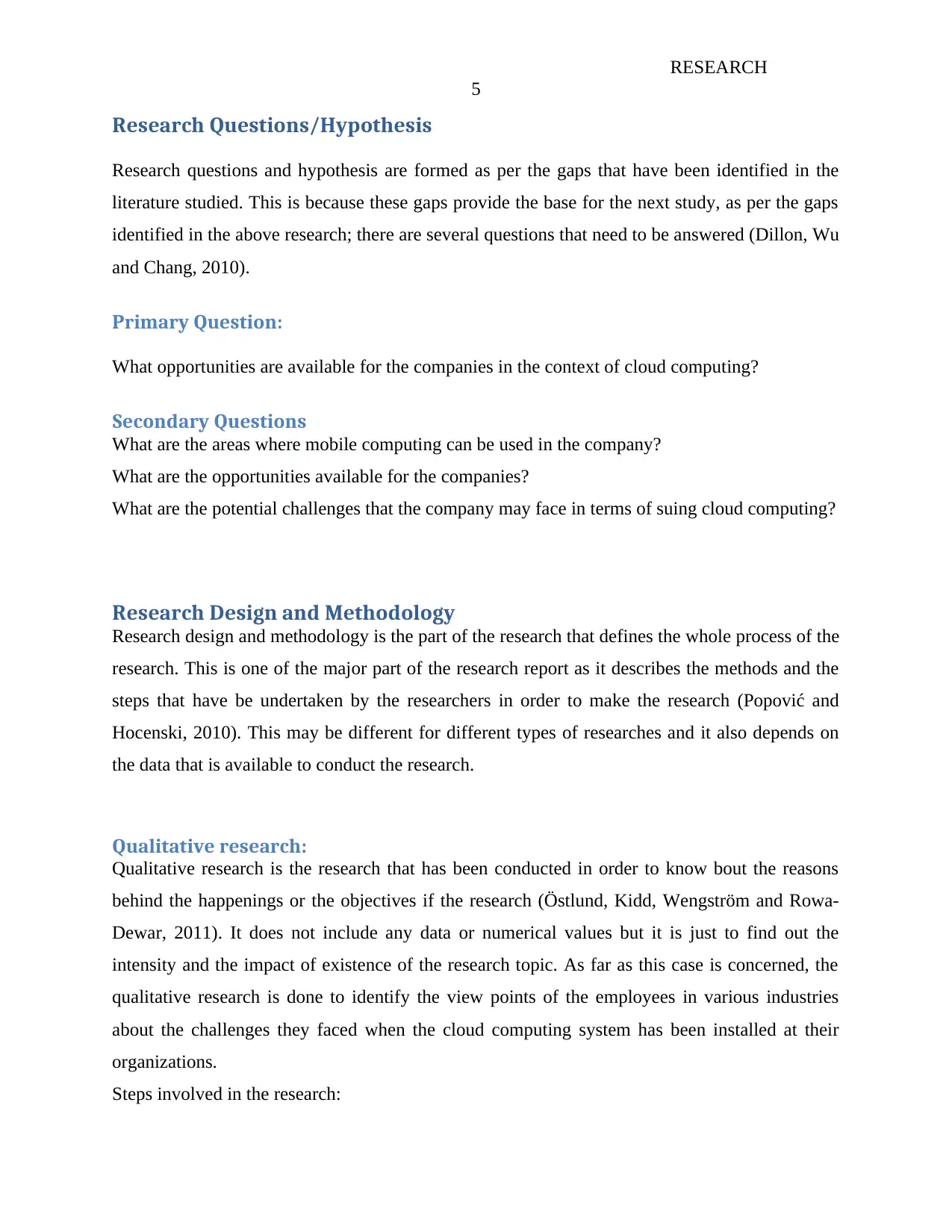
RESEARCH
5
Research Questions/Hypothesis
Research questions and hypothesis are formed as per the gaps that have been identified in the
literature studied. This is because these gaps provide the base for the next study, as per the gaps
identified in the above research; there are several questions that need to be answered (Dillon, Wu
and Chang, 2010).
Primary Question:
What opportunities are available for the companies in the context of cloud computing?
Secondary Questions
What are the areas where mobile computing can be used in the company?
What are the opportunities available for the companies?
What are the potential challenges that the company may face in terms of suing cloud computing?
Research Design and Methodology
Research design and methodology is the part of the research that defines the whole process of the
research. This is one of the major part of the research report as it describes the methods and the
steps that have be undertaken by the researchers in order to make the research (Popović and
Hocenski, 2010). This may be different for different types of researches and it also depends on
the data that is available to conduct the research.
Qualitative research:
Qualitative research is the research that has been conducted in order to know bout the reasons
behind the happenings or the objectives if the research (Östlund, Kidd, Wengström and Rowa-
Dewar, 2011). It does not include any data or numerical values but it is just to find out the
intensity and the impact of existence of the research topic. As far as this case is concerned, the
qualitative research is done to identify the view points of the employees in various industries
about the challenges they faced when the cloud computing system has been installed at their
organizations.
Steps involved in the research:
5
Research Questions/Hypothesis
Research questions and hypothesis are formed as per the gaps that have been identified in the
literature studied. This is because these gaps provide the base for the next study, as per the gaps
identified in the above research; there are several questions that need to be answered (Dillon, Wu
and Chang, 2010).
Primary Question:
What opportunities are available for the companies in the context of cloud computing?
Secondary Questions
What are the areas where mobile computing can be used in the company?
What are the opportunities available for the companies?
What are the potential challenges that the company may face in terms of suing cloud computing?
Research Design and Methodology
Research design and methodology is the part of the research that defines the whole process of the
research. This is one of the major part of the research report as it describes the methods and the
steps that have be undertaken by the researchers in order to make the research (Popović and
Hocenski, 2010). This may be different for different types of researches and it also depends on
the data that is available to conduct the research.
Qualitative research:
Qualitative research is the research that has been conducted in order to know bout the reasons
behind the happenings or the objectives if the research (Östlund, Kidd, Wengström and Rowa-
Dewar, 2011). It does not include any data or numerical values but it is just to find out the
intensity and the impact of existence of the research topic. As far as this case is concerned, the
qualitative research is done to identify the view points of the employees in various industries
about the challenges they faced when the cloud computing system has been installed at their
organizations.
Steps involved in the research:
⊘ This is a preview!⊘
Do you want full access?
Subscribe today to unlock all pages.

Trusted by 1+ million students worldwide
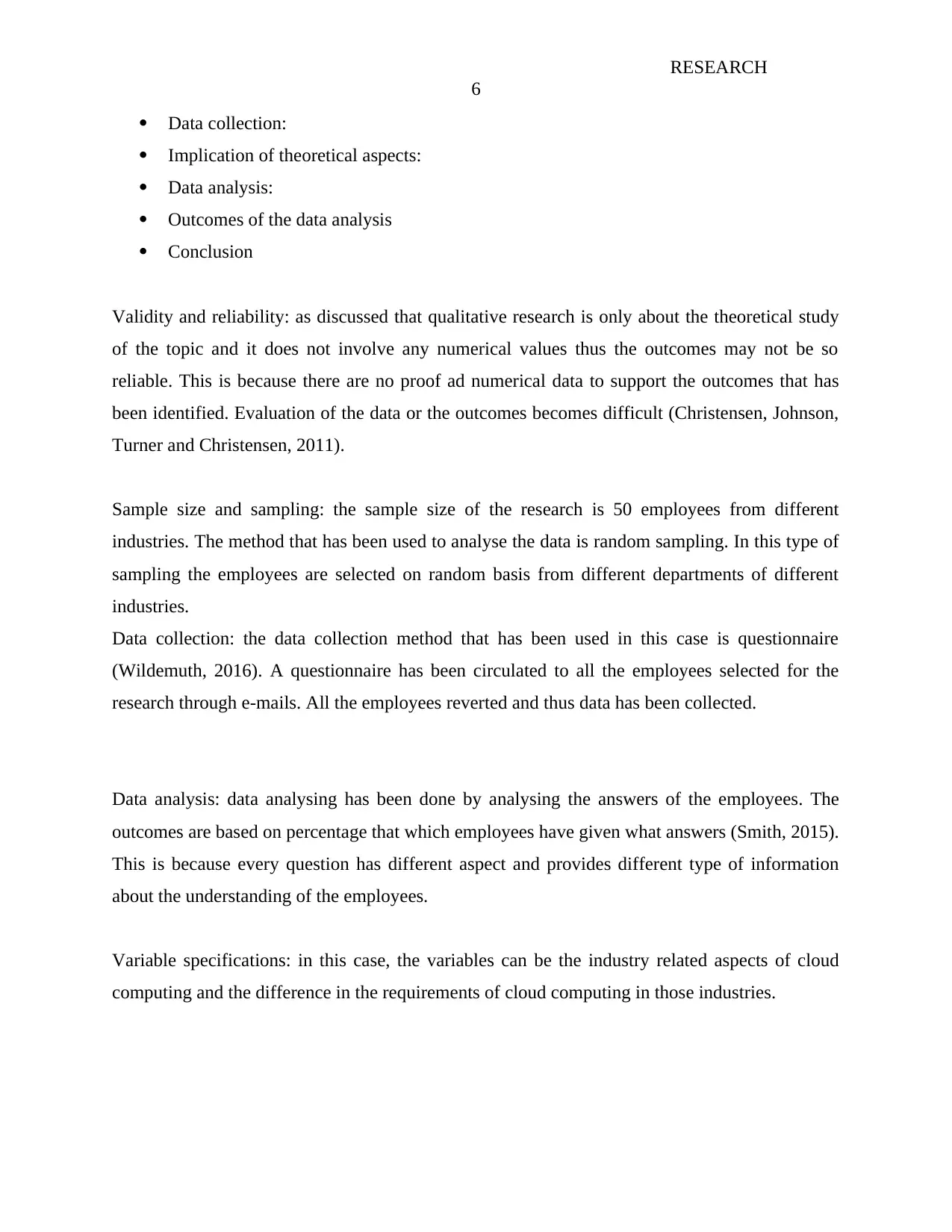
RESEARCH
6
Data collection:
Implication of theoretical aspects:
Data analysis:
Outcomes of the data analysis
Conclusion
Validity and reliability: as discussed that qualitative research is only about the theoretical study
of the topic and it does not involve any numerical values thus the outcomes may not be so
reliable. This is because there are no proof ad numerical data to support the outcomes that has
been identified. Evaluation of the data or the outcomes becomes difficult (Christensen, Johnson,
Turner and Christensen, 2011).
Sample size and sampling: the sample size of the research is 50 employees from different
industries. The method that has been used to analyse the data is random sampling. In this type of
sampling the employees are selected on random basis from different departments of different
industries.
Data collection: the data collection method that has been used in this case is questionnaire
(Wildemuth, 2016). A questionnaire has been circulated to all the employees selected for the
research through e-mails. All the employees reverted and thus data has been collected.
Data analysis: data analysing has been done by analysing the answers of the employees. The
outcomes are based on percentage that which employees have given what answers (Smith, 2015).
This is because every question has different aspect and provides different type of information
about the understanding of the employees.
Variable specifications: in this case, the variables can be the industry related aspects of cloud
computing and the difference in the requirements of cloud computing in those industries.
6
Data collection:
Implication of theoretical aspects:
Data analysis:
Outcomes of the data analysis
Conclusion
Validity and reliability: as discussed that qualitative research is only about the theoretical study
of the topic and it does not involve any numerical values thus the outcomes may not be so
reliable. This is because there are no proof ad numerical data to support the outcomes that has
been identified. Evaluation of the data or the outcomes becomes difficult (Christensen, Johnson,
Turner and Christensen, 2011).
Sample size and sampling: the sample size of the research is 50 employees from different
industries. The method that has been used to analyse the data is random sampling. In this type of
sampling the employees are selected on random basis from different departments of different
industries.
Data collection: the data collection method that has been used in this case is questionnaire
(Wildemuth, 2016). A questionnaire has been circulated to all the employees selected for the
research through e-mails. All the employees reverted and thus data has been collected.
Data analysis: data analysing has been done by analysing the answers of the employees. The
outcomes are based on percentage that which employees have given what answers (Smith, 2015).
This is because every question has different aspect and provides different type of information
about the understanding of the employees.
Variable specifications: in this case, the variables can be the industry related aspects of cloud
computing and the difference in the requirements of cloud computing in those industries.
Paraphrase This Document
Need a fresh take? Get an instant paraphrase of this document with our AI Paraphraser

RESEARCH
7
Quantitative research:
It is the method that is required in the cases where the numerical values are needed to be
discussed and the number and the percentage effect of the research needs to be analysed. The
outcomes from this research may be assumed to be more effective and accurate because data in
figure is available (Jennings, 2012). On the other hand, the errors chances are also very high.
Validity and reliability: It is the research that involves figures and data and thus is more reliable.
The validity of the research or the outcome may be short as the requirements of the companies
may change or the thinking of the people may change with time (Liu, Dong, Guo, Yang and
Peng, 2015).
Sampling and sample size: the sample size in this research is 100 and the sampling method is
cluster sampling. This is because it provides more accurate data in equal ration from different
industries.
Data collection method: The data has been collected by the questionnaire and the interviews.
Questionnaire has been filled by the lower level employees and higher level employees have
been interviews.
Data analysis method: Scaling is done as per the data collected by the researcher from the
employees. As the numerical data is involved in the research thus the outcome is more accurate.
Variable specifications: the variables it is case is the answers given by the employees and their
perception toward cloud computing.
Research Limitations:
There are many limitation of this research which may affect the outcomes of the research or may
deviate the outcome from the original outcomes. The first and the foremost limitation that is
found in the research are about the sample size (Agarwal, 2013). Keeping the sample size small
affect the outcome of the research as small sample size cannot justify the whole population. The
7
Quantitative research:
It is the method that is required in the cases where the numerical values are needed to be
discussed and the number and the percentage effect of the research needs to be analysed. The
outcomes from this research may be assumed to be more effective and accurate because data in
figure is available (Jennings, 2012). On the other hand, the errors chances are also very high.
Validity and reliability: It is the research that involves figures and data and thus is more reliable.
The validity of the research or the outcome may be short as the requirements of the companies
may change or the thinking of the people may change with time (Liu, Dong, Guo, Yang and
Peng, 2015).
Sampling and sample size: the sample size in this research is 100 and the sampling method is
cluster sampling. This is because it provides more accurate data in equal ration from different
industries.
Data collection method: The data has been collected by the questionnaire and the interviews.
Questionnaire has been filled by the lower level employees and higher level employees have
been interviews.
Data analysis method: Scaling is done as per the data collected by the researcher from the
employees. As the numerical data is involved in the research thus the outcome is more accurate.
Variable specifications: the variables it is case is the answers given by the employees and their
perception toward cloud computing.
Research Limitations:
There are many limitation of this research which may affect the outcomes of the research or may
deviate the outcome from the original outcomes. The first and the foremost limitation that is
found in the research are about the sample size (Agarwal, 2013). Keeping the sample size small
affect the outcome of the research as small sample size cannot justify the whole population. The
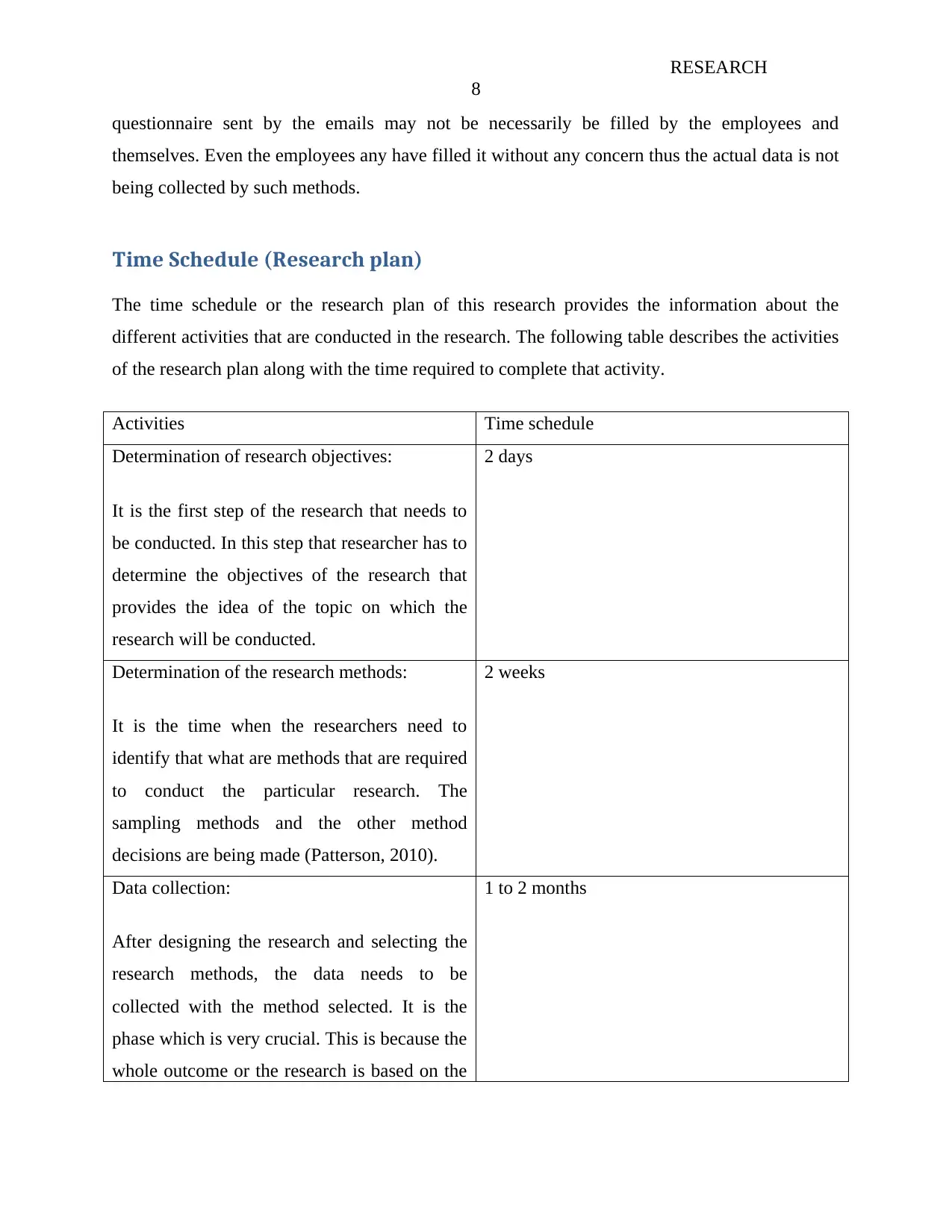
RESEARCH
8
questionnaire sent by the emails may not be necessarily be filled by the employees and
themselves. Even the employees any have filled it without any concern thus the actual data is not
being collected by such methods.
Time Schedule (Research plan)
The time schedule or the research plan of this research provides the information about the
different activities that are conducted in the research. The following table describes the activities
of the research plan along with the time required to complete that activity.
Activities Time schedule
Determination of research objectives:
It is the first step of the research that needs to
be conducted. In this step that researcher has to
determine the objectives of the research that
provides the idea of the topic on which the
research will be conducted.
2 days
Determination of the research methods:
It is the time when the researchers need to
identify that what are methods that are required
to conduct the particular research. The
sampling methods and the other method
decisions are being made (Patterson, 2010).
2 weeks
Data collection:
After designing the research and selecting the
research methods, the data needs to be
collected with the method selected. It is the
phase which is very crucial. This is because the
whole outcome or the research is based on the
1 to 2 months
8
questionnaire sent by the emails may not be necessarily be filled by the employees and
themselves. Even the employees any have filled it without any concern thus the actual data is not
being collected by such methods.
Time Schedule (Research plan)
The time schedule or the research plan of this research provides the information about the
different activities that are conducted in the research. The following table describes the activities
of the research plan along with the time required to complete that activity.
Activities Time schedule
Determination of research objectives:
It is the first step of the research that needs to
be conducted. In this step that researcher has to
determine the objectives of the research that
provides the idea of the topic on which the
research will be conducted.
2 days
Determination of the research methods:
It is the time when the researchers need to
identify that what are methods that are required
to conduct the particular research. The
sampling methods and the other method
decisions are being made (Patterson, 2010).
2 weeks
Data collection:
After designing the research and selecting the
research methods, the data needs to be
collected with the method selected. It is the
phase which is very crucial. This is because the
whole outcome or the research is based on the
1 to 2 months
⊘ This is a preview!⊘
Do you want full access?
Subscribe today to unlock all pages.

Trusted by 1+ million students worldwide
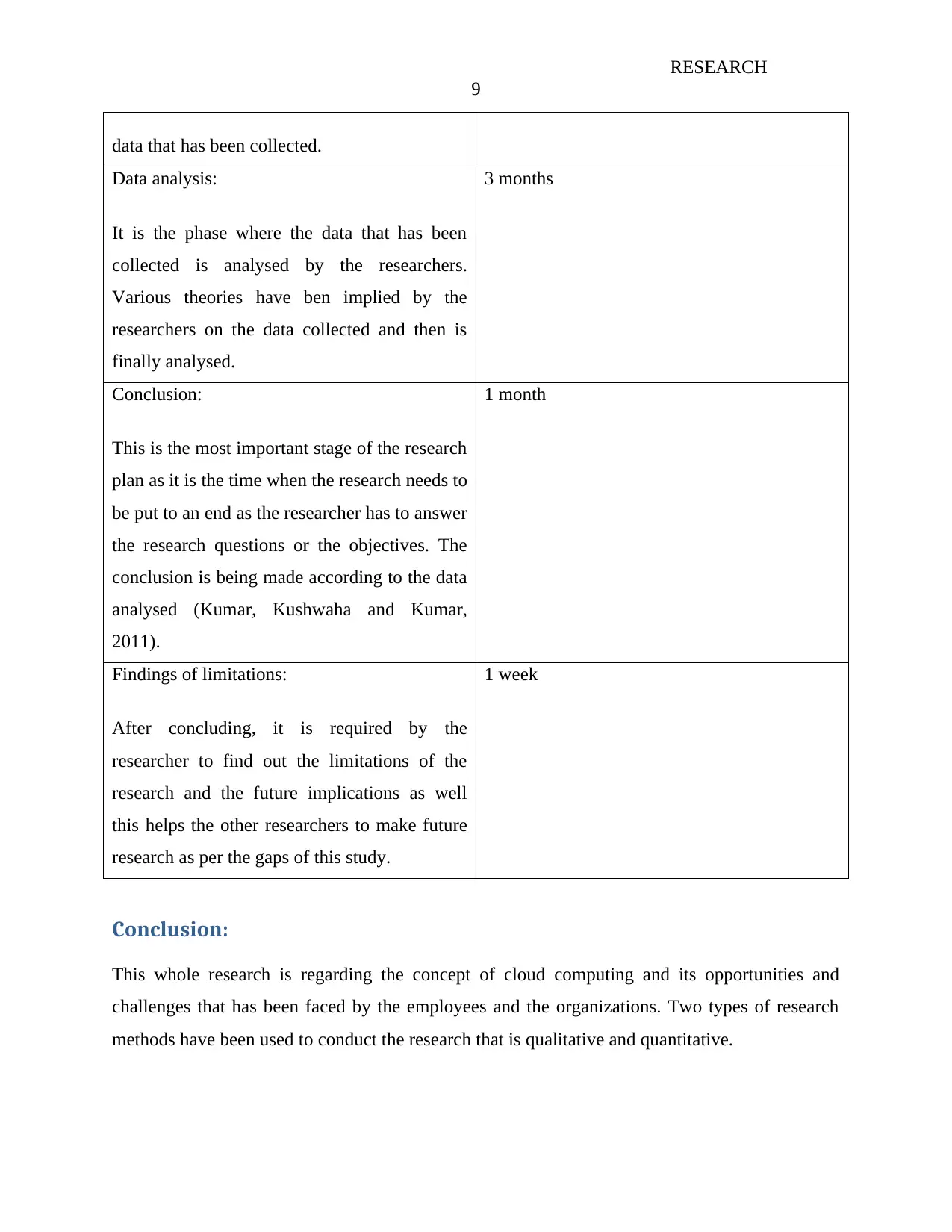
RESEARCH
9
data that has been collected.
Data analysis:
It is the phase where the data that has been
collected is analysed by the researchers.
Various theories have ben implied by the
researchers on the data collected and then is
finally analysed.
3 months
Conclusion:
This is the most important stage of the research
plan as it is the time when the research needs to
be put to an end as the researcher has to answer
the research questions or the objectives. The
conclusion is being made according to the data
analysed (Kumar, Kushwaha and Kumar,
2011).
1 month
Findings of limitations:
After concluding, it is required by the
researcher to find out the limitations of the
research and the future implications as well
this helps the other researchers to make future
research as per the gaps of this study.
1 week
Conclusion:
This whole research is regarding the concept of cloud computing and its opportunities and
challenges that has been faced by the employees and the organizations. Two types of research
methods have been used to conduct the research that is qualitative and quantitative.
9
data that has been collected.
Data analysis:
It is the phase where the data that has been
collected is analysed by the researchers.
Various theories have ben implied by the
researchers on the data collected and then is
finally analysed.
3 months
Conclusion:
This is the most important stage of the research
plan as it is the time when the research needs to
be put to an end as the researcher has to answer
the research questions or the objectives. The
conclusion is being made according to the data
analysed (Kumar, Kushwaha and Kumar,
2011).
1 month
Findings of limitations:
After concluding, it is required by the
researcher to find out the limitations of the
research and the future implications as well
this helps the other researchers to make future
research as per the gaps of this study.
1 week
Conclusion:
This whole research is regarding the concept of cloud computing and its opportunities and
challenges that has been faced by the employees and the organizations. Two types of research
methods have been used to conduct the research that is qualitative and quantitative.
Paraphrase This Document
Need a fresh take? Get an instant paraphrase of this document with our AI Paraphraser
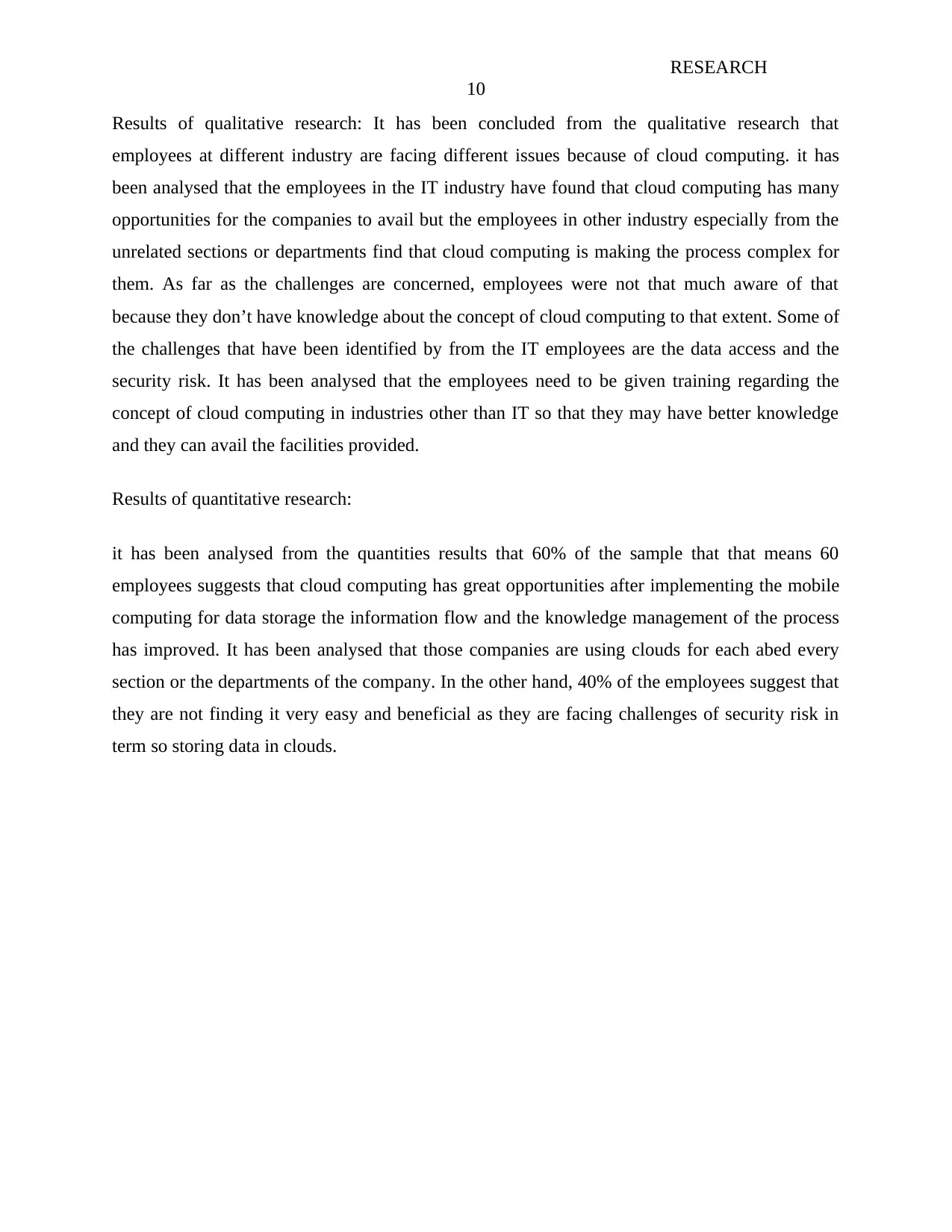
RESEARCH
10
Results of qualitative research: It has been concluded from the qualitative research that
employees at different industry are facing different issues because of cloud computing. it has
been analysed that the employees in the IT industry have found that cloud computing has many
opportunities for the companies to avail but the employees in other industry especially from the
unrelated sections or departments find that cloud computing is making the process complex for
them. As far as the challenges are concerned, employees were not that much aware of that
because they don’t have knowledge about the concept of cloud computing to that extent. Some of
the challenges that have been identified by from the IT employees are the data access and the
security risk. It has been analysed that the employees need to be given training regarding the
concept of cloud computing in industries other than IT so that they may have better knowledge
and they can avail the facilities provided.
Results of quantitative research:
it has been analysed from the quantities results that 60% of the sample that that means 60
employees suggests that cloud computing has great opportunities after implementing the mobile
computing for data storage the information flow and the knowledge management of the process
has improved. It has been analysed that those companies are using clouds for each abed every
section or the departments of the company. In the other hand, 40% of the employees suggest that
they are not finding it very easy and beneficial as they are facing challenges of security risk in
term so storing data in clouds.
10
Results of qualitative research: It has been concluded from the qualitative research that
employees at different industry are facing different issues because of cloud computing. it has
been analysed that the employees in the IT industry have found that cloud computing has many
opportunities for the companies to avail but the employees in other industry especially from the
unrelated sections or departments find that cloud computing is making the process complex for
them. As far as the challenges are concerned, employees were not that much aware of that
because they don’t have knowledge about the concept of cloud computing to that extent. Some of
the challenges that have been identified by from the IT employees are the data access and the
security risk. It has been analysed that the employees need to be given training regarding the
concept of cloud computing in industries other than IT so that they may have better knowledge
and they can avail the facilities provided.
Results of quantitative research:
it has been analysed from the quantities results that 60% of the sample that that means 60
employees suggests that cloud computing has great opportunities after implementing the mobile
computing for data storage the information flow and the knowledge management of the process
has improved. It has been analysed that those companies are using clouds for each abed every
section or the departments of the company. In the other hand, 40% of the employees suggest that
they are not finding it very easy and beneficial as they are facing challenges of security risk in
term so storing data in clouds.
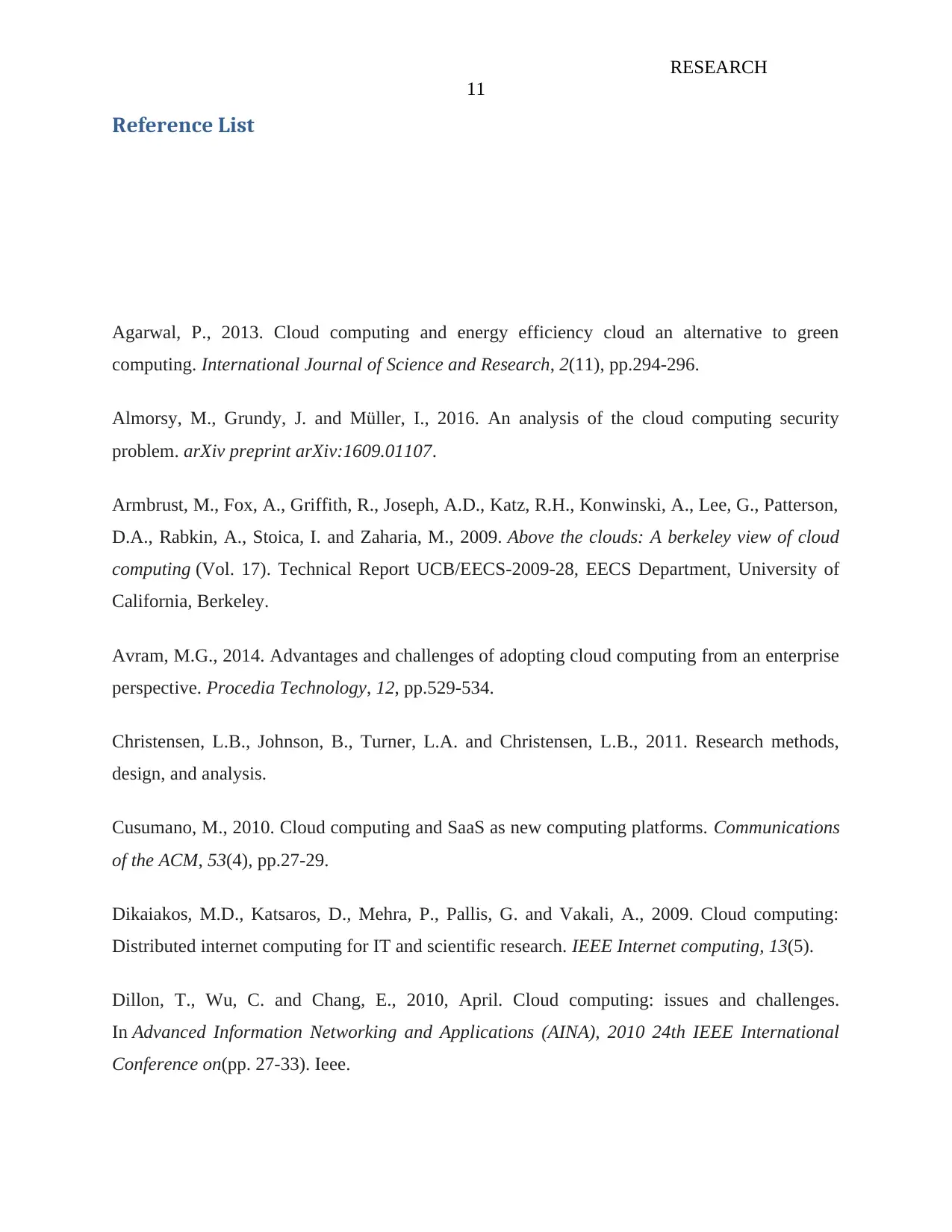
RESEARCH
11
Reference List
Agarwal, P., 2013. Cloud computing and energy efficiency cloud an alternative to green
computing. International Journal of Science and Research, 2(11), pp.294-296.
Almorsy, M., Grundy, J. and Müller, I., 2016. An analysis of the cloud computing security
problem. arXiv preprint arXiv:1609.01107.
Armbrust, M., Fox, A., Griffith, R., Joseph, A.D., Katz, R.H., Konwinski, A., Lee, G., Patterson,
D.A., Rabkin, A., Stoica, I. and Zaharia, M., 2009. Above the clouds: A berkeley view of cloud
computing (Vol. 17). Technical Report UCB/EECS-2009-28, EECS Department, University of
California, Berkeley.
Avram, M.G., 2014. Advantages and challenges of adopting cloud computing from an enterprise
perspective. Procedia Technology, 12, pp.529-534.
Christensen, L.B., Johnson, B., Turner, L.A. and Christensen, L.B., 2011. Research methods,
design, and analysis.
Cusumano, M., 2010. Cloud computing and SaaS as new computing platforms. Communications
of the ACM, 53(4), pp.27-29.
Dikaiakos, M.D., Katsaros, D., Mehra, P., Pallis, G. and Vakali, A., 2009. Cloud computing:
Distributed internet computing for IT and scientific research. IEEE Internet computing, 13(5).
Dillon, T., Wu, C. and Chang, E., 2010, April. Cloud computing: issues and challenges.
In Advanced Information Networking and Applications (AINA), 2010 24th IEEE International
Conference on(pp. 27-33). Ieee.
11
Reference List
Agarwal, P., 2013. Cloud computing and energy efficiency cloud an alternative to green
computing. International Journal of Science and Research, 2(11), pp.294-296.
Almorsy, M., Grundy, J. and Müller, I., 2016. An analysis of the cloud computing security
problem. arXiv preprint arXiv:1609.01107.
Armbrust, M., Fox, A., Griffith, R., Joseph, A.D., Katz, R.H., Konwinski, A., Lee, G., Patterson,
D.A., Rabkin, A., Stoica, I. and Zaharia, M., 2009. Above the clouds: A berkeley view of cloud
computing (Vol. 17). Technical Report UCB/EECS-2009-28, EECS Department, University of
California, Berkeley.
Avram, M.G., 2014. Advantages and challenges of adopting cloud computing from an enterprise
perspective. Procedia Technology, 12, pp.529-534.
Christensen, L.B., Johnson, B., Turner, L.A. and Christensen, L.B., 2011. Research methods,
design, and analysis.
Cusumano, M., 2010. Cloud computing and SaaS as new computing platforms. Communications
of the ACM, 53(4), pp.27-29.
Dikaiakos, M.D., Katsaros, D., Mehra, P., Pallis, G. and Vakali, A., 2009. Cloud computing:
Distributed internet computing for IT and scientific research. IEEE Internet computing, 13(5).
Dillon, T., Wu, C. and Chang, E., 2010, April. Cloud computing: issues and challenges.
In Advanced Information Networking and Applications (AINA), 2010 24th IEEE International
Conference on(pp. 27-33). Ieee.
⊘ This is a preview!⊘
Do you want full access?
Subscribe today to unlock all pages.

Trusted by 1+ million students worldwide
1 out of 14
Related Documents
Your All-in-One AI-Powered Toolkit for Academic Success.
+13062052269
info@desklib.com
Available 24*7 on WhatsApp / Email
![[object Object]](/_next/static/media/star-bottom.7253800d.svg)
Unlock your academic potential
Copyright © 2020–2025 A2Z Services. All Rights Reserved. Developed and managed by ZUCOL.




